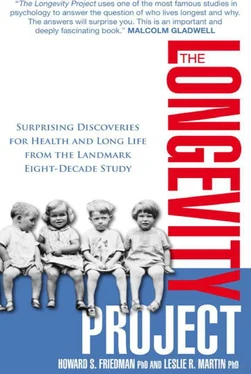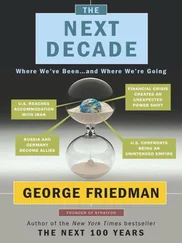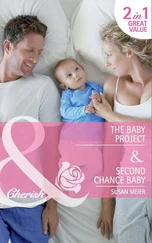Jess Oppenheimer and Shelley Smith Mydans, like most of the Terman participants, were interesting people who, when not at work, were involved with family, friends, and hobbies. Most married and stayed married, but a significant number did not. Some were extroverted and others unsociable. Some were impulsive and others prudent. Many of the Terman participants faced significant personal and social difficulties and did not make it into their seventies and eighties. Some of their life paths led to health and long life while others dramatically increased the risks of illness and premature death.
Do You Fit the Bill? Assess Yourself
Always amusing to us is the way that the most objective health scientists become personally caught up in this research. Whenever we present our scientific findings at a research conference, our fellow professionals immediately try to see if they themselves fit the profile of the long-lived. Although the ability to predict health outcomes in any individual case is limited, it is possible to recognize patterns that can lead to meaningful changes. So throughout this book we present relevant measures and risk assessments—self-quizzes, if you will. Often these include some of the same questions Dr. Terman used decades ago. These assessments also serve to provide a deeper understanding of the ideas we’re discussing. For example, here is a typical item (from one of the measures):
I am persistent in the accomplishment of my work and ends.
Not true of me 1 2 3 4 5 Very true of me
In later chapters, we present quizzes and measures (and scoring) that you can use to assess yourself:
• Are you conscientious in a health-relevant sense?
• Do you have a sociable personality? And are you a good emotional communicator?
• Are you a moody worrier?
• Are you a gloomy Chicken Little?
• Did your early education predispose you to long life?
• Are you satisfied with your life in a way that impacts your health?
• How physically active are you—on a scientific scale?
• If married, how happy is your marriage?
• How healthy is your job (for you)?
• How do you score on three key measures of social relationships, and especially on the scale most relevant to long life?
• How does your level of religiosity (or lack thereof) impact your health?
• How masculine or feminine are you?
• Are you at risk from health-harming chronic stress?
As they grew older, the children in Dr. Terman’s study recognized that they were in a special group and in a special study, although no one thought the study would last more than ten or twenty years, much less for eight decades. Giving their identity a special name, they cleverly called themselves “Terman’s Termites” or, more simply, “the Termites.”
We sometimes use this nickname, “Termites,” when referring to the participants in Terman’s project. But there are dangers: at one scientific conference, we attempted to present a technical display called “The Longevity of the Termites,” but the conference attendees simply ignored us, walking right by our informative exhibit. They evidently assumed that we were entomologists studying wood-eating social insects. Now we are more careful in our terminology.
In any scientific research project, much of the drudgery of data gathering and handling falls to graduate students, who are apprenticed to more established researchers. Our particular project has attracted a number of remarkable graduate student researchers over the years, but after a while they tired of being known as students of “Dr. Friedman’s longevity project developing the Terman data.” Back in 2005, our graduate students decided that if the participants could be “Termites,” then we researchers could be “Termanators.” And so they hung a sign outside our lab door: The Termanator Lab .
Because we were working at the University of California in Riverside, only about fifty miles east of Hollywood, the name seemed to fit. Despite the nonviolent nature of our work, the plot is the same—to save human lives.
CHAPTER 1
Personality and Long Life
Who Stays Well?
Patricia and John, two of the Terman participants who lived the longest, led interesting, but not startling, lives. 3 3 In this book, we report our major findings in terms of group associations, common trajectories, and pathways to long life. When we present descriptions of Terman participants who have been publicly identified (such as Jess Oppenheimer and Shelley Smith Mydans), the information is factual and unaltered. When we use confidential case studies to illustrate key points, we use pseudonyms and alter some of the details in unimportant ways, so as not to breach the confidentiality that Terman promised the children and their parents. Dr. Terman used the same sorts of disguise when he presented anecdotes to illustrate his findings.
They encountered adventures and surprises but never won a lottery, crashed their cars, or confronted a kidnapper. In this respect, they were quite different from Ann Hodges, an ordinary American who faced an extraordinary event. On November 30, 1954, a meteorite crashed through the roof and injured thirty-one-year-old Ms. Hodges as she lay dozing on her couch in Oak Grove, Alabama.
If a meteor falls out of the sky and strikes you, there is probably little you could have done to prevent it. Some threats are random and unpredictable, at least as far as one can scientifically judge. But many such seemingly chance events are not totally random. Golfers on a Kansas City course who gather under a tree during a storm are more likely to be struck by lightning, for instance, than is a librarian in Los Angeles (where it rarely even thunders).
Surprisingly, the same is true for health. It is not random who will contract the flu or who will recover quickly. Many health threats are not simply due to bad luck. Rather, there are systematic individual differences in susceptibility to injury and disease, who gets sick and who stays well. Some of these are a function of personality—stable individual differences, including associated biological differences. Others are tied to social relations such as marriage, family, friendship, and religious observance. Still others emerge from stressful challenges and the resources one can muster in facing the stress. Most important is our finding that the risk factors and protective shields do not occur in isolation but bunch together in patterns—the healthy or unhealthy life paths or trails that we call pathways. The pathways to long life had unforeseen twists, many of which amazed us.
When young Patricia was led out of her classroom to be tested by Dr. Terman, her parents had recently divorced. Although children of divorce face many risks, including health risks (our studies have confirmed this, as we’ll show), Patricia was able to avoid them, partly because she later had a good marriage herself. In contrast, her classmate John went against the grain and never married. Yet he, too, lived a long and healthy life. Our studies of personality, marriage, and longevity showed why. Conventional wisdom failed, but a focus on individual pathways yielded insights and understanding—and allowed us to shatter dead-end myths.
It’s especially important to be attuned to your own pathway because modern medical professionals will not do it for you. Most physicians, many of whom are highly trained to heal one specific part or system of the body, don’t ask about your personality traits, your activity levels as a child, or your family’s history of divorce and remarriage. In fact, if you want to understand how you can find your optimal path to health and long life, modern medicine has relatively little to offer. Instead we need to turn to the contemporary fields of health psychology, medical sociology, life-course epidemiology, genetics, and life-span development.
Читать дальше











